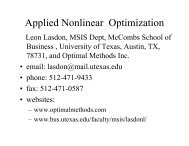[PDF] ALIO Back Matter
[PDF] ALIO Back Matter
[PDF] ALIO Back Matter
Create successful ePaper yourself
Turn your PDF publications into a flip-book with our unique Google optimized e-Paper software.
SC11<br />
4 - The Spread Versus the Chromatic Number of a Graph<br />
Lima Leonardo, Professor, CEFET-RJ, Rio de Janeiro, Brazil,<br />
leolima.geos@gmail.com, Nair Abreu, Aroldo Oliveira<br />
Let G be a connected graph with n vertices. The spread of G is the spread of its<br />
adjacency matrix A(G) and it is defined as the difference between the largest and<br />
the smallest eigenvalues of A(G). The chromatic number, a known graph invariant,<br />
is the minimum number of colors needed to color the vertices of a graph such that<br />
no two adjacent vertices have the same color. For several classes of graphs, we<br />
prove that the chromatic number is a lower bound to the spread.<br />
■ SC11<br />
Aula 362- Third Floor<br />
New Developments in Algorithms and Software<br />
Cluster: Nonlinear Optimization<br />
Invited Session<br />
Chair: Ernesto G. Birgin, Associate Professor, Universidade de São Paulo,<br />
Rua do Matao, 1010, Cidade Universitária, São Paulo, SP, 05508-090,<br />
Brazil, egbirgin@ime.usp.br<br />
1 - LRAMBO - Efficient NLP Solving<br />
Torsten Bosse, Humboldt Universität zu Berlin, Unter den Linden 6,<br />
Berlin, 10099, Germany, bosse@math.hu-berlin.de,<br />
Andreas Griewank<br />
In this talk we present the NLP-solver ‘LRAMBO’ and the underlying theory that is<br />
based on a total quasi-Newton method exploiting the benefits of Algorithmic<br />
Differentiation. A highly efficient step computation is guaranteed by an<br />
approximation of the active constraint Jacobian and a hot-start for the factorized<br />
KKT-system in terms of low-rank updating. For large scale optimization we propose<br />
a limited memory implementation with compact storage for the approximating<br />
Hessian.<br />
2 - Optimization Tools in MATLAB<br />
Marcelo Marazzi, MathWorks, 3 Apple Hill Dr, Natick, MA, 02138,<br />
United States of America, marazzi@gmail.com<br />
We describe optimization functions that extend the MATLAB technical computing<br />
environment. These functions address a number of common optimization problems<br />
such as nonlinear, linear, quadratic, single- and multi-objective. Methods<br />
implemented in these functions are varied and include gradient-based, derivativefree,<br />
deterministic, and non-deterministic algorithms. We overview these functions<br />
and other features such as parallel computing, MATLAB compiler, and a graphical<br />
user interface.<br />
3 - Comparing Box-constrained Minimization Solvers<br />
Ernesto G. Birgin, Associate Professor, Universidade de São Paulo,<br />
Rua do Matao, 1010, Cidade Universitária, São Paulo, SP, 05508-090,<br />
Brazil, egbirgin@ime.usp.br, Jan Marcel Gentil<br />
Box-constrained minimization is a dynamic area of practical optimization. In this<br />
work, a comparison between some classical and recently developed methods is<br />
presented. The comparison includes ASA (W. Hager and H. Zhang, A New Active<br />
Set Algorithm for Box Constrained Optimization, SIOPT 17, 526-557, 2006) and<br />
GENCAN (E.G. Birgin and J.M. Martínez, “Large-scale active-set box-constrained<br />
optimization method with spectral projected gradientsCOAP 23, 101-125, 2002),<br />
among others.<br />
4 - Simulation and Optimization of 2010 FIFA World Cup<br />
José Mario Martínez, Universidade Estadual de Campinas -<br />
UNICAMP, IMECC, CP6065, Campinas SP, 13081-970, Brazil,<br />
martinez@ime.unicamp.br, Julián Martínez<br />
We developed a simulation model for the 2010 FIFA World Cup. The parameters of<br />
the model are the coefficients of a function that relates a ranking of the participants<br />
with the probability of different results of each game. The optimization process<br />
consists of fitting these parameters with respect to overall beliefs of the user. Given<br />
the best fit one can deduce probabilistic information that should be compatible with<br />
the user prognostics.<br />
<strong>ALIO</strong> / INFORMS International – 2010<br />
38<br />
■ SC12<br />
Aula 363- Third Floor<br />
Supply Chain Management II<br />
Contributed Session<br />
Chair: Kevin Li, PhD, Associate Professor, University of Windsor, Odette<br />
School of Business, Windsor, ON, N9B 3P4, Canada, kwli@uwindsor.ca<br />
1 - Bayesian Dynamic Models in Supply Chain Forecasting<br />
Victor Aguirre, Professor, ITAM, Rio Hondo # 1, Mexico, DF, 01080,<br />
Mexico, aguirre@itam.mx, Gabriel Cervantes<br />
Supply chain management depends heavily in the timely generation of forecasts<br />
that take into account information provided by different actors of the chain.<br />
Bayesian models provides great flexibility to incorporate prior information on the<br />
generation of forecasts. In particular we explore the approach of some Dynamic<br />
Linear Models to forecast sales series. Comparison of these procedures with other<br />
commonly used methods of forecasting shows a strong superiority of the Bayesian<br />
approach.<br />
2 - Impacts of RFID on Customer Service<br />
Pedro Reyes, Baylor University, One Bear Place #98006, Waco, TX,<br />
76798, United States of America, pedro_reyes@baylor.edu,<br />
Patrick Jaska, Gregory Heim<br />
Since the big bang of RFID, the attention has primarily been given to the retail<br />
supply chain and focused on improving performance. Yet, little attention has been<br />
given to how RFID impacts service operations. We study the RFID applications used<br />
to enhance service operations focusing on the service delivery system. We report on<br />
field studies of RFID initiatives at five different service firms and examined<br />
practitioner case studies of RFID deployments.<br />
3 - Decision Support Model for Information Systems Integration in<br />
Supply Chains<br />
Antonio Diaz, Professor, Polytechnic Institute J. A. Echeverria, Ave.<br />
114 # 11901, Marianao, Havana, Cuba, diaztony@tesla.cujae.edu.cu,<br />
Dania Perez<br />
The integration of information systems in supply chains is a problem that is still far<br />
from solved because the selection complexity of a combination of technologies to<br />
support the chain performance. This paper proposes an approach for a decision<br />
support model, based on compensatory fuzzy logic, to facilitate the selection of<br />
technologies to be used for integrating the information systems in a supply chain.<br />
4 - A Game-theoretic Analysis on Social Responsibility Conduct in<br />
Two-echelon Supply Chains<br />
Kevin Li, PhD, Associate Professor, University of Windsor, Odette<br />
School of Business, Windsor, ON, N9B 3P4, Canada,<br />
kwli@uwindsor.ca, Debing Ni<br />
This article investigates how supply chain members interact with each other with<br />
respect to corporate social responsibility (CSR) behavior and what are the impacts of<br />
exogenous factors on this interaction. This research puts the interaction between the<br />
supply chain partners in the context of strategic games. A game-theoretic analysis is<br />
conducted and equilibriums are expected to be obtained for both sequential-move<br />
and simultaneous-move game settings.<br />
■ SC13<br />
Aula 364- Third Floor<br />
Supply Chain - Optimization II<br />
Contributed Session<br />
Chair: Navneet Vidyarthi, Assistant Professor, John Molson School of<br />
Business, Decision Sciences and MIS, 1455 De Maisonneuve West,<br />
Montréal, H3G1M8, Canada, navneetv@jmsb.concordia.ca<br />
1 - Support Decisions Models in the Oils and Fats Industry on<br />
Emerging Market Economies<br />
Maria Ximen Sierra, Engineer, Universidad de la Sabana,<br />
Puente del Común, Chía, Chia, 140013, Colombia,<br />
maria.sierra3@unisabana.edu.co, Luz Andrea Torres, Julian Madero,<br />
Edgar Gutierrez<br />
Its presents the mathematical modeling for supply chain of oil and fat industry,<br />
minimizing logistics distribution costs of final products. This model includes<br />
distribution centers and local sales. The costs involved are transportation, inventory<br />
and administration. The restrictions are: capacity of distribution centers and<br />
transportations, demand satisfaction and balance equations.


![[PDF] ALIO Back Matter](https://img.yumpu.com/17932960/18/500x640/pdf-alio-back-matter.jpg)
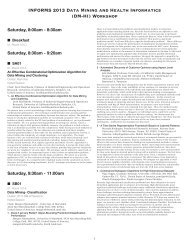
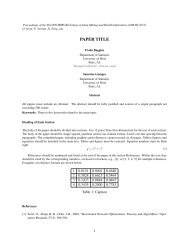
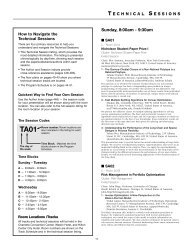
![[PDF] Charlotte Back Matter](https://img.yumpu.com/17933057/1/190x245/pdf-charlotte-back-matter.jpg?quality=85)

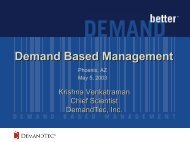
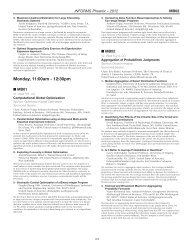
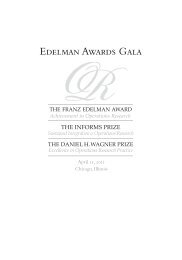
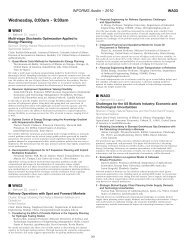
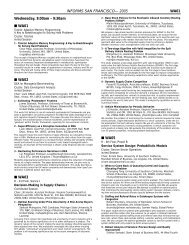
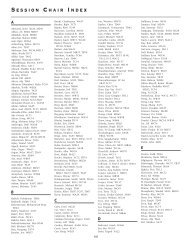
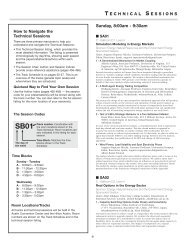
![[PDF] Monday, 8:00am - 9:30am](https://img.yumpu.com/17932954/1/190x245/pdf-monday-800am-930am.jpg?quality=85)
